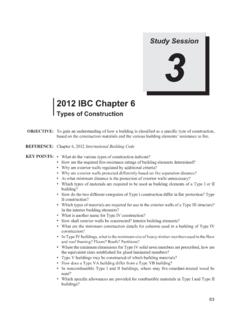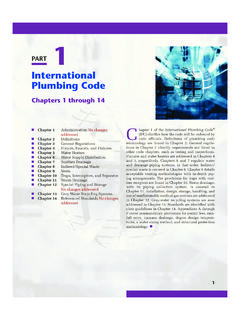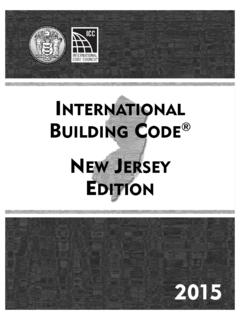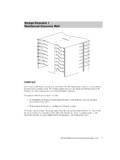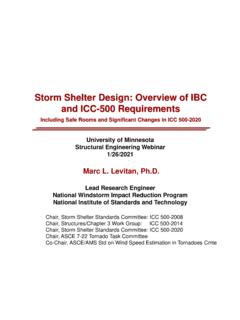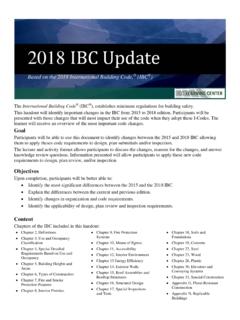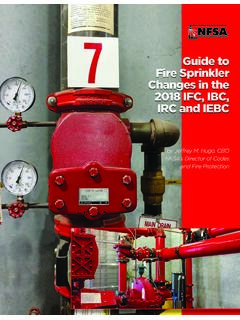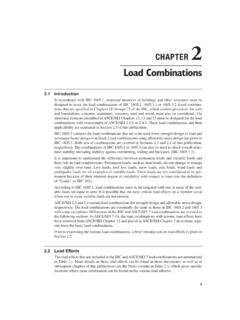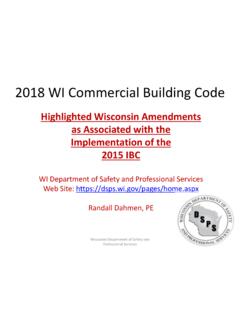Transcription of Chapter 3: Occupancy Classification and Use
1 2018 IBC CODE and COMMENTARY3-1 Chapter 3: Occupancy Classification and UseGeneral CommentsChapter 3 provides for the Classification of buildings,structures and parts thereof into Occupancy groupsbased on the purpose or purposes for which they 302 identifies the Occupancy groups intowhich all buildings, structures and parts thereof must 303 through 312 identify the occupancycharacteristics of each group Classification . In somesections, specific group classifications having require-ments in common are collectively organized such thatone term applies to all. For example, Groups A-1, A-2,A-3, A-4 and A-5 are individual groups. The generalterm Group A, however, includes each of these individ-ual groups. For this reason, each specific assemblygroup Classification is included in Section 303.
2 Definitions play a key role in determining the occu-pancy Classification . All definitions are located in Chap-ter 2. In the early years of building code development, theessence of regulatory safeguards from fire was to pro-vide a reasonable level of protection to property. Theidea was that if property was adequately protected fromfire, then the building occupants would also be this outlook on fire safety, the concept of equiv-alent risk has evolved in the code. This concept main-tains that, in part, an acceptable level of risk against thedamages of fire respective to a particular occupancytype (group) can be achieved by limiting the height andarea of buildings containing such occupancies accord-ing to the building's construction type ( , its relativefire endurance).
3 The concept of equivalent risk involves three interde-pendent considerations:1. The level of fire hazard associated with the spe-cific Occupancy of the The reduction of fire hazard by limiting the floorareas and the height of the building based onthe fuel load (combustible contents and burn-able building components).3. The level of overall fire resistance provided bythe type of construction used for the interdependence of these fire safety consider-ations can be seen by first looking at Tables 601 and602, which show the fire-resistance ratings of the princi-pal structural elements comprising a building in relationto the five classifications for types of construction. Type Iconstruction is the Classification that generally requiresthe highest fire-resistance ratings for structural ele-ments, whereas Type V construction, which is desig-nated as a combustible type of construction, generallyrequires the least amount of fire-resistance-rated struc-tural elements.
4 If one then looks at Tables , , the relationship among Occupancy classifica-tion, allowable heights, and areas and types of construc-tion becomes apparent. Respective to each occupancyclassification, the greater the fire-resistance rating ofstructural elements, as represented by the type of con-struction, the greater the floor area and height allow-ances. The greater the potential fire hazards indicatedas a function of the group, the lesser the height and areaallowances for a particular construction a result of extensive research and advancementsin fire technology, today s building codes are more com-prehensive and complex regulatory instruments thanthey were in the earlier years of code the principle of equivalent risk remains an import-ant component in building codes, perspectives havechanged and life safety is now the paramount fire so, Occupancy Classification still plays a key part inorganizing and prescribing the appropriate protectionmeasures.
5 As such, threshold requirements for fire pro-tection and means of egress systems are based onoccupancy Classification (see Chapters 9 and 10).Other sections of the code also contain requirementsrespective to the Classification of building groups. Forexample, Section 705 addresses requirements for exte-rior wall fire-resistance ratings that are tied to the occu-pancy Classification of a building and Section interior finish requirements that are dependentupon the Occupancy purpose of this Chapter is to classify a building,structure or part thereof into a group based on the spe-cific purpose for which it is designed, occupied andused. Throughout the code, Occupancy group classifica-tions are considered a fundamental principle in organiz-ing and prescribing the appropriate features ofconstruction and occupant safety requirements forbuildings, especially general building limitations, meansof egress, fire protection systems and interior Classification AND USE3-22018 IBC CODE and COMMENTARYSECTION General.
6 The provisions of this Chapter shall controlthe Classification of all buildings and structures as to occu-pancy and use. Different classifications of Occupancy and userepresent varying levels of hazard and risk to building occu-pants and adjacent properties. As used throughout the code, the Classification of anoccupancy into a group is established by the require-ments of this Chapter . The purpose of these provi-sions is to provide rational criteria for theclassification of various occupancies into groupsbased on their relative fire hazard and life safetyproperties. This is necessary because the code uti-lizes group Classification as a fundamental principlefor differentiating requirements in other parts of thecode related to fire and life safety 302 Occupancy CLASSIFICATIONAND USE Occupancy Classification .
7 Occupancy Classification isthe formal designation of the primary purpose of the building,structure or portion thereof. Structures shall be classified intoone or more of the Occupancy groups listed in this sectionbased on the nature of the hazards and risks to building occu-pants generally associated with the intended purpose of thebuilding or structure. An area, room or space that is intendedto be occupied at different times for different purposes shallcomply with all applicable requirements associated with suchpotential multipurpose. Structures containing multiple occu-pancy groups shall comply with Section 508. Where a struc-ture is proposed for a purpose that is not specifically listed inthis section, such structure shall be classified in the occu-pancy it most nearly resembles based on the fire safety andrelative hazard.
8 Occupied roofs shall be classified in thegroup that the Occupancy most nearly resembles, according tothe fire safety and relative hazard, and shall comply with Sec-tion Assembly (see Section 303): Groups A-1, A-2, A-3,A-4 and Business (see Section 304): Group Educational (see Section 305): Group Factory and Industrial (see Section 306): Groups F-1and High Hazard (see Section 307): Groups H-1, H-2, H-3, H-4 and Institutional (see Section 308): Groups I-1, I-2, I-3and Mercantile (see Section 309): Group Residential (see Section 310): Groups R-1, R-2, R-3and Storage (see Section 311): Groups S-1 and Utility and Miscellaneous (see Section 312): GroupU. This section requires all structures to be classified inone or more of the groups listed according to thestructure s purpose and function ( , its Occupancy ).
9 By organizing occupancies with similar fire hazardand life safety properties into groups, the code hasincorporated the means to differentiate occupanciessuch that various fire protection and life safetyrequirements can be rationally organized andapplied. Each specific group has an individual classi-fication. Each represents a different characteristicand level of fire hazard that requires special codeprovisions to lessen the associated risks. There aresome group classifications that are very closelyrelated to other specific groups and, therefore, arecollectively referred to as a single group ( , GroupF applies to Groups F-1 and F-2). In these cases,there are requirements within the code that are com-mon to each specific group Classification .
10 These com-mon requirements are applicable based on thereference to the collective Classification . For example,the automatic sprinkler system requirement of Sec-tion applies to each specific group classifica-tion (R-1, R-2, R-3 and R-4) listed under the term Group R. Although many requirements applicable toa general Occupancy Classification are the same forall of the subclassifications within the occupancygroup, there are enough differences to warrant thedivision of the general category into two or more spe-cific : Both a restaurant (Group A-2) and achurch (Group A-3) are included in Group A, but theyhave different specific group classifications. BothGroups A-2 and A-3 are subject to the same traveldistance limitations (see Table ) and corridorfire-resistance ratings (see Table ), but havedifferent thresholds for when automatic sprinkler sys-tems are required (see Section 903).
